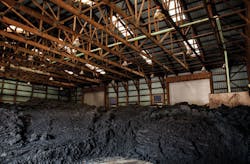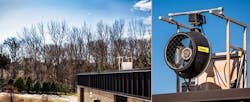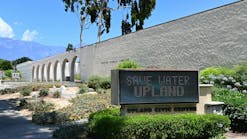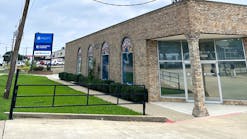| A chemical storage building next to the primary clarifiers is being used to elevate the Odor Fan for greater coverage to reach the neighborhood residents in close proximity. |
Odor Comes with the Territory
As any wastewater professional knows, odor comes with the territory. The reality is that most wastewater treatment plants have multiple odor-generating areas, which include pump stations, headworks, primary clarifiers, digesters, lagoons, and sludge handling areas. Odors that are generally associated with this process include hydrogen sulfide, ammonia, sulfur dioxide, skatoles, mercaptans, amines, and indoles.
Customized Atomization Solution
As is typical in wastewater treatment plants, the sludge-handling areas often contain the strongest odors. As such, it was critical that the District develop a customized solution that aggressively addressed the sludge.
Through its partnership with OMI Industries, the District was able to develop an atomization solution that used Ecosorb®, an eco-friendly odor abatement solution often used in landfills, oil refineries and other municipal wastewater facilities -- without the use of odor-masking agents.
Because the District did not have water for product dilution, a 450 CFM Vapor Phase unit was selected to treat odors emanating from the sludge storage building. It generates sub-micron-sized droplets of the Ecosorb 606, which are dispersed into the build using a PVC header system placed in the rafters that run down the middle of the building. The system is only used when sludge cake is being added to or removed from the building.
Fighting Odor at the Preliminary Treatment Building
Since all of the raw sewage comes into the preliminary treatment building for processing, the District also undertook an atomization effort to control airborne odors in this part of the facility.
As such, the District installed at 2.0-gallon-per-minute (GPM) High-Pressure System that distributes Ecosorb atomization through a hydraulic high-pressure system. This system treats odors by dispersing a fine mist into the air to simultaneously treat escaping gas emissions and surface odors. Screw pumps are used to lift the raw sewage into the preliminary treatment building, and even though it's covered, odors still escape. To mitigate this issue, the District has surrounded the area with high-pressure atomization nozzles. This system has been used continuously during the summer months.
Neighbor-Friendly Odor Fan
With luxury homes abutting the facility's property, the District decided to develop another customized solution -- the Odor Fan -- to be a good neighbor and further mitigate odors. The customized fan dispersal system was installed atop the chemical building. It runs when odors are present and when the wind direction might impact neighbors. The fan emits a steady flow of Ecosorb, which can be adjusted anytime, and can be pointed directly at neighbors' properties.
Why We Went Eco-Friendly
The safety of employees, neighbors and the environment is paramount to the Wheaton Sanitary District. Since there are a number of recreational parks, fields and tree-lined areas next to the plant, the District did not want to use a chemical-based solution that could potentially cause undue damage.
As such, Ecosorb products are non-toxic, contain no hazardous VOCs, and have been scientifically proven to be safe for both the environment and humans. These products have also been tested against Environmental Protection Agency Guidelines and have received the safest possible classification.
Conclusion
The District's goal is to ensure that it provides the most effective wastewater treatment services while also being a good neighbor. Thanks to taking a proactive odor management approach, it has been able to significantly reduce complaints while also ensuring that it is not negatively impacting the environment -- which is a win-win for everyone.
About the Author: Sue Baert is the plant superintendent at Wheaton Sanitary District.




